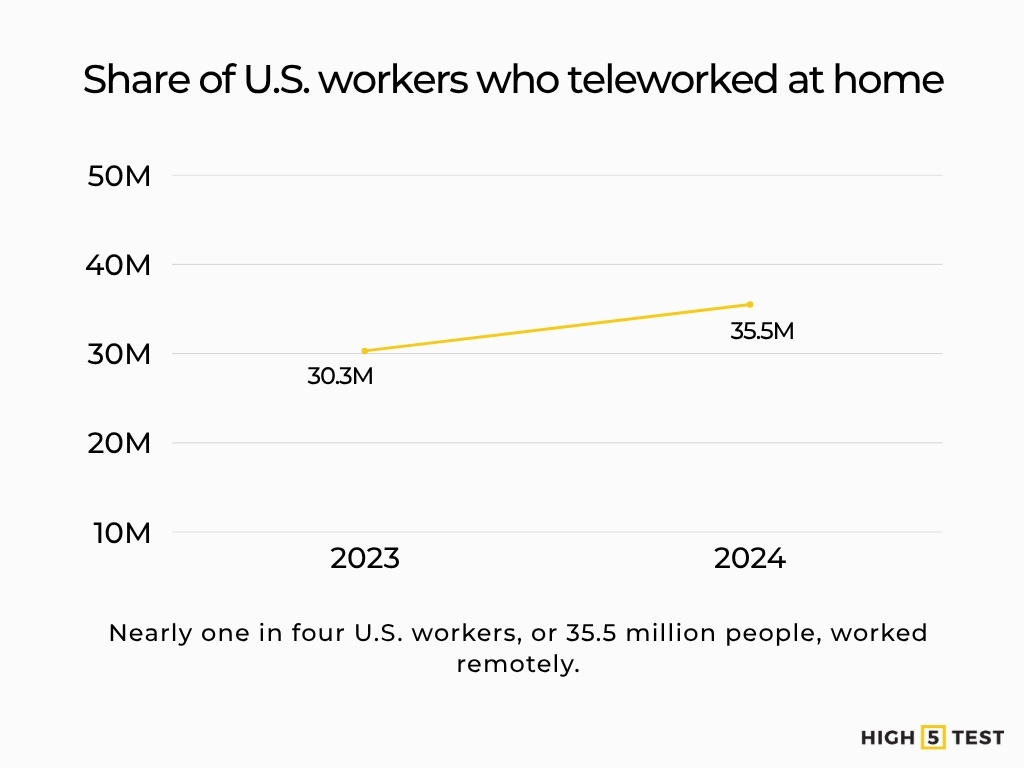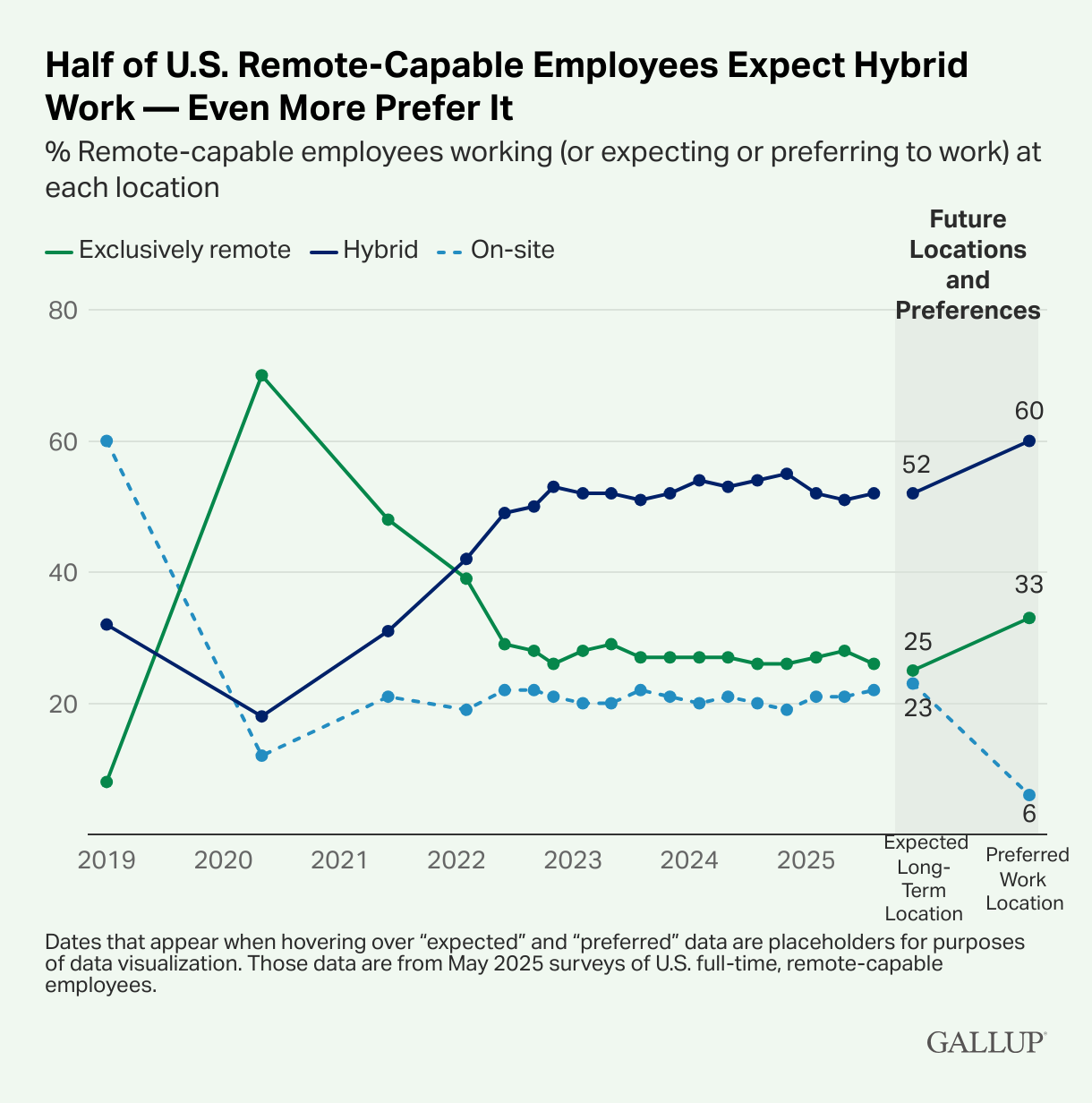Remote work surged during the pandemic and then settled at a higher level. In early 2024, 22.9% of U.S. workers teleworked at least part-time, about 35.5 million people. That share was 19.6% a year earlier.
About 55% of U.S. jobs can be done remotely. Globally, roughly 28% of the workforce works from home. The ability to work remotely has become a major factor in employment and turnover. Among U.S. employees in telework-capable jobs, 75% work from home at least some of the time, and nearly half say they would likely leave if that option disappeared.
10 most interesting remote work statistics in the US & global (2024–2025)
- In early 2024, 22.9% of U.S. workers (≈ 35.5 million people) teleworked at least part-time, up from 19.6% one year earlier.
- 55% of U.S. jobs are classified as “telework-eligible” (i.e., could be done remotely at least part-time).
- Only about 6% of U.S. employees want to work in the office full-time; ~60% prefer hybrid, ~33% prefer fully remote.
- Among workers in tele-capable jobs, 75% work from home at least some of the time; and 46% say they’d likely quit if forced back on-site full-time.
- Remote work rates vary greatly by race: Q1 2024 data show Asian workers 32.8%, White 23.2%, Black 17.1%, Hispanic/Latino 12.4%.
- In Q1 2024, workers aged 16-24 had the lowest telework rate (7.9%), while 25–54 year-olds had ~25.1%.
- Industry-by-industry: the tech sector leads at ~67% remote participation; by contrast, food service is ~4.8%, construction ~7.8%.
- Remote workers report higher engagement: one study shows 31% of remote workers feel highly engaged vs 19% for on-site staff.
- Remote work yields major savings: A fully-remote U.S. employee reportedly saves about $10,000/year on average (commute, meals, apparel, etc.). Employers also save ~$10,600 per employee/year on overhead.
- Environmental/commute impact: full-time remote work can cut commuter carbon emissions by ~58%; even hybrid (1-2 days remote/week) can reduce emissions by ~2-29%.
Remote work statistics in the US
35.5 million U.S. workers (22.9% of those at work) teleworked or worked at home, a 3.3-point increase from 19.6% one year earlier.

Source: Bureau of Labor Statistics
Working Remotely: 26% of U.S. employees work exclusively remotely; by contrast, an estimated 28% of workers worldwide do so. Fully remote arrangements are now mainstream in the United States and closely match the global share.
Remote-Capable Jobs: Over half of U.S. jobs are telework-eligible (55% of workers can work remotely at least part-time). 56% of U.S. jobs are at least partially remote-compatible. With more than half of all jobs adaptable to remote setups, flexibility is now a defining aspect of the modern workplace.
Source: Gallup, Global Workplace Analytics
Historical Trend: Remote work share tripled during the pandemic. At its peak in ~2020, nearly 70% of workers teleworked weekly, stabilizing to roughly 25–30% currently. What began as an emergency shift has matured into a stable share of one-quarter to one-third of the workforce.

Source: Gallup
Statistics on employee preferences and work arrangements
Hybrid vs. Remote Demand: Only about 6% of U.S. employees want to work in the office full-time. Surveys find 60% prefer a hybrid schedule and 33% fully remote. Another report states that 52% of remote-capable workers are already hybrid, 26% fully remote, and only 22% fully on-site.

Source: Gallup
Remote as a Priority: A majority of workers rank remote options highly. For example, only 20% say they’d be very likely to stay with an employer if their employer no longer allowed them to work from home. Another finds 75% of employees with telework-capable jobs use the option at least sometimes, and 46% say they’d likely quit if forced back on-site full-time.
Source: Pew Research Center
Gender and Preferences: Remote flexibility is especially valued by women: 60% of women (and 52% of men) surveyed would quit rather than lose all remote privileges.
Source: FlexJobs
Employer adoption and current job market stats
Hybrid Work Policies: In 2025 surveys, 88% of U.S. employers report offering some hybrid work options. About 25% of companies say hybrid work is available to all employees. Even a small amount of remote flexibility can aid hiring and retention.
Source: Robert Half
Job Postings: Remote-capable job postings have grown. In Q2 2025, 24% of new U.S. job ads were hybrid and 12% fully remote. By comparison, fully on-site listings fell from 83% of all postings in early 2023 to 66% by late 2024. This suggests roughly one-third of new jobs now include a remote component.

Source: Robert Half
Seniority and Geography: Flexible work is more common in senior roles (e.g., 31% of new senior roles are hybrid vs 14% fully remote), and is increasingly offered in smaller or rural markets to attract talent.

Source: Robert Half
Forecasts: Analysts predict the hybrid/remote share will remain high or grow, as about 25% of the workforce is expected to work remotely at least part-time. Nearly half (51%) of U.S. workers with remote-capable jobs currently enjoy a hybrid schedule.
Source: Gallup
Statistics on remote workforce demographics
Gender: 24.9% of women with a job teleworked in Q1 2024 vs 21.1% of men. (Other data note men (49.6%) still slightly outnumber women (46.4%) among those who are remote, reflecting overall workforce composition.)
Source: Bureau of Labor Statistics, SelectSoftware Reviews
Age: Middle-aged workers dominate remote work. In Q1 2024, 25–54 year-olds had the highest telework rate (25.1%), while 16–24 year-olds had the lowest (7.9%). Millennials (25–39) now account for the largest share of remote employees (48%).

Source: Bureau of Labor Statistics, SelectSoftware Reviews
Race/Ethnicity: Telework rates vary by race. Data (Q1 2024) show Asian workers had the highest telework rate (32.8%), compared to White (23.2%), Black (17.1%), and Hispanic/Latino (12.4%) workers.

Source: Bureau of Labor Statistics
Other Factors: Workers with disabilities are more likely to telework (24.4%) than those without disabilities (22.8%). Independent surveys show, for instance, that Gen Z adults (ages 18–24) are the least likely to apply for remote jobs (23%), while parents of young children place a particularly high value on remote work options.
Source: Bureau of Labor Statistics, Gallup, Remote
Statistics on remote work by industry and occupation
Tech and Professional Services: The tech sector leads: about 67% of tech workers operate remotely (the highest of any industry). Consulting and professional services also rank high, with 50.6% and 48.7% of finance/insurance workers working remotely.

Source: Statista, Bureau of Labor Statistics
Education and Government: Education saw a surge during COVID, but recent data shows roughly 17.8% of educators and librarians still worked remotely. The U.S. federal and state governments have varying policies; incoming policy changes (e.g., 2025 administration) may affect remote rates.
Source: Bureau of Labor Statistics
Low-Remote Occupations: Essential services lag far behind. Data show very low remoteability in fields like food service (4.8%), transportation (8.8%), and construction (7.8%). Healthcare is about 11.3% remote (mainly telehealth/admin).

Source: Bureau of Labor Statistics
White-Collar vs. Blue-Collar: In general, white-collar professional roles (tech, finance, legal, business, computer/math) often exceed 50% telework participation, whereas blue-collar and service jobs remain largely on-site.
Source: Bureau of Labor Statistics
Stats on productivity, engagement, and well-being of remote employees
Productivity: Multiple studies find equal or higher productivity for remote workers. One study reports a 69% productivity boost from working at home. Another report says remote-capable employees report high engagement: 31% of remote workers feel highly engaged, versus 19% of on-site staff.

Work-Life Balance: A major benefit of remote work is flexibility. A survey found 81.4% of teleworkers say it greatly helps their work-life balance. Saving commute time contributes: on average, a remote worker saves about 55 minutes per day (US data), or 72 minutes globally.

Source: Bospar, National Bureau of Economic Research
Stress and Well-Being: Surveys indicate remote work can reduce stress and burnout. For example, 93% of remote workers in one survey reported a positive mental health impact. Men and women agree that remote work generally reduces stress and improves well-being.
Source: FlexJobs
Engagement and Retention: Employees with remote options tend to be more satisfied and loyal. 31% say remote access influences their decision to stay or leave a job. Another report states that 76% of workers say flexible work strongly affects their desire to stay with an employer.
Source: Pumble, Robert Half
Collaboration: One drawback is coworker connection: over half of teleworkers (53%) say remote work hurts their sense of workplace community (though overall satisfaction with co-worker relationships remains high across all work modes).
Source: Pew Research Center
Economic and environmental impacts of remote work
Individual Savings: Remote workers cut costs on commuting, meals, and work apparel. One report estimates a fully remote U.S. employee saves ~$10,000/year on average (fuel, food, childcare, etc.). Hybrid workers (half-time remote) save about $6,000/year.

Employer Savings: Companies also save by eliminating office space, utilities, and equipment, and save roughly $10,600 per employee per year. These overhead reductions drive many firms to embrace long-term remote or hybrid models.
Source: Lemon.io
Urban and Housing Markets: Remote work has influenced housing demand: areas outside major cities have seen rising home prices, partly credited to relocated remote workers. (For example, U.S. home prices rose ~24% from 2019–2021; remote work accounted for much of this increase.)
Source: Bureau of Labor Statistics
Environment: Fewer commutes mean lower emissions. Studies indicate full-time remote work can cut commuter carbon emissions by ~58%. Even one or two days remote per week yields a significant drop (~2–29% depending on days). Over time, widespread remote adoption could substantially reduce traffic congestion and pollution.
Source: Proceedings of the National Academy of Sciences
Outlook and conclusion
Hybrid and remote work are projected to remain high. Robert Half forecasts that about one-third of jobs will be hybrid or remote. Global Workplace Analytics estimates 35 to 40 percent of workers will keep working from home. Retention risk is clear: six in ten fully remote employees would look for a new job if the option were removed.
Collaboration tools also increased in adoption, and async practices are spreading. High remote levels are prompting moves to lower-cost areas and location-based pay. Policy and sustainability targets will also influence adoption. Taken together, flexible work looks durable.
It is now a stable part of the labor market. Employers that define clear hybrid standards and train managers compete better for talent. They should also invest in secure tools and align pay with performance. Workers gain time savings, wider job access, and better balance. Track outcomes, commute impact, and office use, then adjust policies to fit business needs and local regulations.

